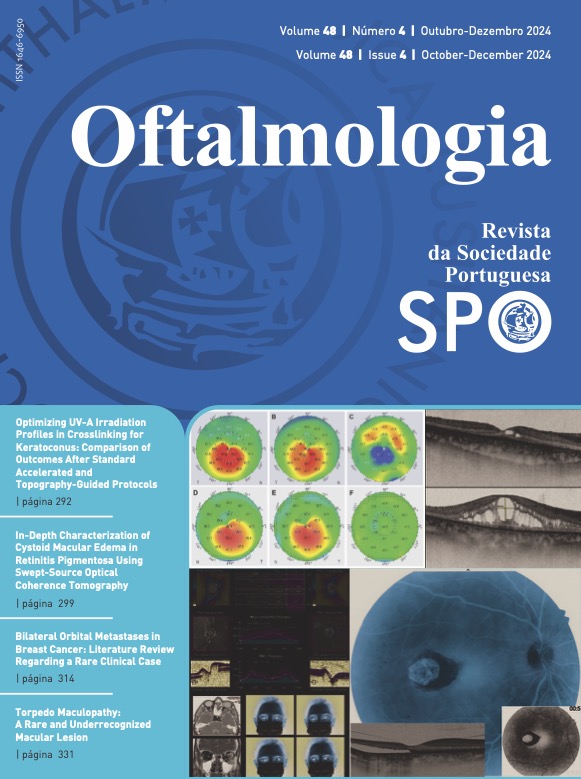Real-World Refractive and Visual Outcomes of Toric Intraocular Lens Rayone® and Performance of the Raytrace® Calculator
DOI:
https://doi.org/10.48560/rspo.33263Keywords:
Cataract, Astigmatism, Lenses, Intraocular, Lens Implantation, IntraocularAbstract
INTRODUCTION: Considering the growing availability of toric intraocular lenses (IOLs) in cataract surgery, real-world refractive outcome data are needed to aid in the decision-making process and IOL selection. The aim of this study is to evaluate the refractive outcomes associated with the implantation of RayOne®toric IOL, the performance of the Raytrace®OnlinePremiumIOL calculator, and the presence of predictive factors for surgical success.METHODS: A retrospective observational study of 163 eyes who underwent cataract surgery with the implantation of RayOne®toric IOL from May 2022 to March 2023 at Centro Hospitalar Entre o Douro e Vouga, Portugal.
RESULTS: A total of 163 eyes (120 patients, 67 women, average age 73.1±9.0 years) were included. The mean keratometry was 44.13±1.90 diopters (D), and corneal cylinder was -1.99 [-2.40;-1.63] D. Biometry was performed using (1)IOLMaster®500 (Zeiss) in 92 (56.4%) eyes; (2) AL-Scan®(Nidek) in 47 (28.8%) eyes; (3)PacScanPlus®(SonomedEscalon) in combination with TonorefII® keratometer(Nidek) in 13 (8.0%) eyes; and (4)Pentacam®(Oculus) in 11 (6.7%) eyes. The IOL power calculation considered the manufacturer’s provided mean posterior corneal astigmatism (PCA) in 61 (37.4%) eyes. Preoperative best-corrected visual acuity, spherical equivalent (SE), sphere, and cylinder were 0.30 [0.22;0.40] logMAR, -1.17±3.31 D, -0.49±3.00 D, and -1.38±2.02 D, respectively. Postoperatively, these values were 0 [0;0.10] logMAR, -0.41±0.65 D, -0.07±0.58 D, and -0.68±0.78 D, respectively. The difference between manifest refraction and the calculator prediction was SE -0.19±0.63 D, sphere 0.08±0.58 D, and cylinder -0.55±0.78 D. There were no statistically significant differences in manifest refraction or between manifest and calculator prediction in groups with or without PCA inclusion. Differences in the prediction error of the calculator were observed between biometers – EE: 2 and 3 (-0.33±0.67 D vs 0.29±0.69 D, p=0.01), 3 and 4 (0.29±0.69 D vs -0.45±0.91 D, p=0.02); cylinder 3 and 4 (-0.44±0.91 D vs -1.29±0.65 D, p=0.04), 1 and 4 (-0.61±0.76 D vs -1.29±0.65 D, p=0.03). LIO rotation exceeding 10º occurred in 5 cases, with one requiring repositioning, posterior capsule rupture in one case, and human error in IOL calculation or ordering in two cases.
CONCLUSION: Ultrasound biometry tends to induce hypermetropia, while Pentacam® undercorrect cylinder compared to other biometers. In real-world scenarios, RayOne®toric IOL and Raytrace®OnlinePremiumIOL calculator demonstrate good refractive and visual results, safety, accuracy in estimated refraction, and rotational stability.
Downloads
References
Brogan K, Diaper CJM, Rotchford AP. Cataract surgery refractive outcomes: representative standards in a National Health Service setting. Br J Ophthalmol. 2019;103:539-43. doi: 10.1136/bjophthalmol-2018-312209.
Lundström M, Dickman M, Henry Y, Manning S, Rosen P, Tassignon MJ, et al. Risk factors for refractive error after cataract surgery: Analysis of 282 811 cataract extractions reported to the European Registry of Quality Outcomes for cataract and refractive surgery. J Cataract Refract Surg. 2018;44:447–52. doi: 10.1016/j.jcrs.2018.01.031.
Kessel L, Andresen J, Tendal B, Erngaard D, Flesner P, Hjortdal J. Toric intraocular lenses in the correction of astigmatism during cataract surgery: a systematic review and meta-analysis. Ophthalmology. 2016;123:275-86. doi: 10.1016/j.ophtha.2015.10.002.
Khan MI, Muhtaseb M. Prevalence of corneal astigmatism in patients having routine cataract surgery at a teaching hospital in the United Kingdom. J Cataract Refract Surg. 2011;37:1751–5. doi: 10.1016/j.jcrs.2011.04.026.
Guan Z, Yuan F, Yuan YZ, Niu WR. Analysis of corneal astigmatism in cataract surgery candidates at a teaching hospital in Shanghai, China. J Cataract Refract Surg. 2012;38:1970–7. doi: 10.1016/j.jcrs.2012.07.025.
Patel CK, Ormonde S, Rosen PH, Bron AJ. Postoperative intraocular lens rotation. Ophthalmology. 1999;106:2190–6.
Arba-Mosquera S, Merayo-Lloves J, de Ortueta D. Clinical effects of pure cyclotorsional errors during refractive surgery. Invest Ophthalmol Vis Sci. 2008;49:4828-36. doi: 10.1167/iovs.08-1766.
Rubenstein JB, Raciti M. Approaches to corneal astigmatism in cataract surgery. Curr Opin Ophthalmol. 2013;24:30–4. doi: 10.1097/ICU.0b013e32835ac853.
Mozayan E, Lee JK. Update on astigmatism management. Curr Opin Ophthalmol. 2014;25:286–90. doi: 10.1097/ICU.0000000000000068.
Visser N, Bauer NJC, Nuijts RM. Toric intraocular lenses: Historical overview, patient selection, IOL calculation, surgical techniques, clinical outcomes, and complications. J Cataract Refract Surg. 2013;39:624–37. doi: 10.1016/j.jcrs.2013.02.020.
Laurendeau C, Lafuma A, Berdeaux G. Modelling lifetime cost consequences of toric compared with standard IOLs in cataract surgery of astigmatic patients in four European countries. J Med Econ. 2009;12:230–7. doi: 10.3111/13696990903257439.
Preussner PR, Hoffmann P, Wahl J. Impact of posterior corneal surface on toric intraocular lens (IOL) calculation. Curr Eye Res. 2015;40:809–14. doi: 10.3109/02713683.2014.959708.
Reitblat O, Levy A, Kleinmann G, Abulafia A, Assia EI. Effect of posterior corneal astigmatism on power calculation and alignment of toric intraocular lenses: Comparison of methodologies. J Cataract Refract Surg. 2016;42:217–25. doi: 10.1016/j.jcrs.2015.11.036.
Novis C. Astigmatism and toric intraocular lenses. Curr Opin Ophthalmol. 2000;11:47–50. doi: 10.1097/00055735-200002000-00007.
Felipe A, Artigas JM, Díez-Ajenjo A, García-Domene C, Alcocer P. Residual astigmatism produced by toric intraocular lens rotation. J Cataract Refract Surg. 2011;37:1895–901. doi: 10.1016/j.jcrs.2011.04.036.
Jin H, Limberger IJ, Ehmer A, Guo H, Auffarth GU. Impact of axis misalignment of toric intraocular lenses on refractive outcomes after cataract surgery. J Cataract Refract Surg. 2010;36:2061–72. doi: 10.1016/j.jcrs.2010.06.066.
Lee BW, Galor A, Feuer WJ, Pouyeh B, Pelletier JS, Vaddavalli PK, et al. Agreement between Pentacam and IOLMaster in patients undergoing toric IOL implantation. J Refract Surg. 2013;29:114-20. doi: 10.3928/1081597X-20130117-06.
Park DY, Lim DH, Hwang S, Hyun J, Chung TY. Comparison of astigmatism prediction error taken with the Pentacam measurements, Baylor nomogram, and Barrett formula for toric intraocular lens implantation. BMC Ophthalmol. 2017;17:156. doi: 10.1186/s12886-017-0550-z.
Wade M, Steinert RF, Garg S, Farid M, Gaster R. Results of toric intraocular lenses for post-penetrating keratoplasty astigmatism. Ophthalmology. 2014;121:771–7. doi: 10.1016/j.ophtha.2013.10.011.
Stewart CM, McAlister JC. Comparison of grafted and non-grafted patients with corneal astigmatism undergoing cataract extraction with a toric intraocular lens implant. Clin Exp Ophthalmol. 2010;38:747–57. doi: 10.1111/j.1442-9071.2010.02336.x.
Kersey JP, O’Donnell A, Illingworth CD. Cataract surgery with toric intraocular lenses can optimize uncorrected post-operative visual acuity in patients with marked corneal astigmatism. Cornea. 2007;26:133–5.
Cha D, Kang SY, Kim SH, Song JS, Kim HM. New axis-marking method for a toric intraocular lens: mapping method. J Refract Surg. 2011;27:375-9. doi: 10.3928/1081597X-20101005-01.
Downloads
Published
How to Cite
Issue
Section
License
Copyright (c) 2024 Revista Sociedade Portuguesa de Oftalmologia

This work is licensed under a Creative Commons Attribution-NonCommercial 4.0 International License.
Do not forget to download the Authorship responsibility statement/Authorization for Publication and Conflict of Interest.
The article can only be submitted with these two documents.
To obtain the Authorship responsibility statement/Authorization for Publication file, click here.
To obtain the Conflict of Interest file (ICMJE template), click here





